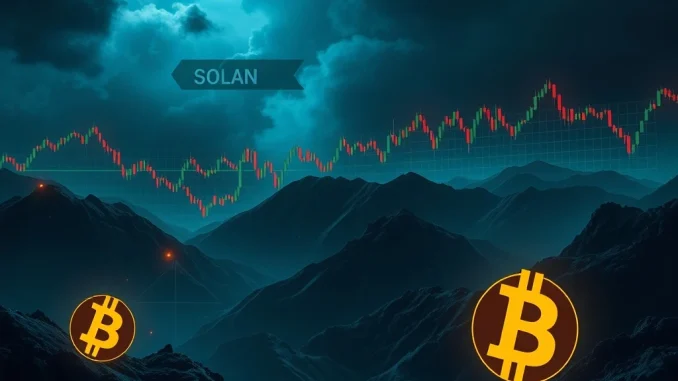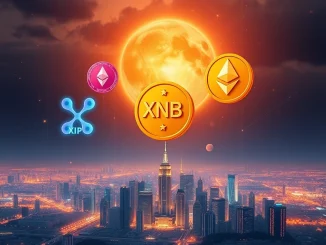
The cryptocurrency market is a realm of exhilarating highs and sudden, gut-wrenching lows. For many traders, the allure of amplified gains through leverage is strong, particularly in the fast-paced world of perpetual futures. But what happens when these leveraged positions go south? We get liquidations – a critical, albeit often painful, mechanism that helps reset market imbalances. Over the past 24 hours, the crypto landscape witnessed a significant wave of crypto liquidations, offering a stark reminder of the inherent volatility and risks involved.
Understanding Perpetual Futures and the Liquidation Cascade
Before diving into the numbers, let’s quickly grasp the fundamentals. Perpetual futures are a type of derivative contract that allows traders to speculate on the future price of a cryptocurrency without actually owning the underlying asset. Unlike traditional futures, they don’t have an expiry date, hence ‘perpetual’. They are popular for their flexibility and the ability to trade with leverage.
However, leverage is a double-edged sword. While it can magnify profits, it also amplifies losses. When a trader’s position falls below a certain margin requirement due to adverse price movements, it triggers a ‘liquidation’. This means the exchange automatically closes the position to prevent further losses, often resulting in significant capital loss for the trader. These forced closures can create a cascade effect, pushing prices further in the direction of the initial move, leading to more liquidations.
The Shocking 24-Hour Crypto Liquidation Breakdown
The last 24 hours have been particularly active, showcasing substantial liquidations across major cryptocurrencies. Here’s a detailed look at the figures:
Total Liquidations (Last 24 Hours):
- Bitcoin (BTC): $111.61 million, with 59.41% being short positions.
- Ethereum (ETH): $137.84 million, with a dominant 64.35% from long positions.
- Solana (SOL): $36.07 million, with an overwhelming 77.28% from short positions.
These figures represent hundreds of millions of dollars wiped out from traders’ accounts, painting a vivid picture of market sentiment and the impact of recent price action.
What Triggered the BTC Liquidation Wave?
The BTC liquidation figures show a clear bias towards short positions being liquidated. This indicates that a significant number of traders were betting on Bitcoin’s price to fall, likely anticipating a deeper market correction or reacting to recent macroeconomic news. When Bitcoin’s price either held strong or saw a slight rebound, these short positions were squeezed, leading to forced closures. A higher percentage of short liquidations suggests a market that resisted bearish pressure, at least temporarily. Traders who opened short positions with high leverage, expecting a continuation of a downtrend, were caught off guard by any upward price movement or consolidation, leading to their demise.
The Ethereum Liquidation Enigma: Why So Many Longs?
In stark contrast to Bitcoin, Ethereum saw the majority of its liquidations come from long positions. The ETH liquidation total of $137.84 million, with 64.35% being longs, suggests that many traders were overly optimistic about Ethereum’s immediate price trajectory. This could be due to a variety of factors:
- Over-leveraged bullish bets: Traders might have opened large long positions, expecting a rally that didn’t materialize or was cut short.
- Sudden price drops: Even small, swift downturns can be enough to trigger liquidations for highly leveraged long positions.
- Market correlation: While ETH often moves with BTC, it can also have its own unique drivers, and perhaps specific news or technical levels led to a concentration of long positions vulnerable to a dip.
This long-heavy liquidation suggests that bullish sentiment for ETH was perhaps overextended, leading to a significant flush of leveraged positions.
Solana’s Plunge: Decoding the SOL Liquidation
Solana’s SOL liquidation data stands out with an astonishing 77.28% of its $36.07 million in liquidations coming from short positions. This is a powerful indicator. It suggests that a vast majority of leveraged traders were betting against SOL, expecting its price to decline significantly. However, if SOL experienced a sudden upward movement or even just a period of unexpected stability, these short positions would have been rapidly closed out. This kind of heavy short liquidation can sometimes precede or accompany a short squeeze, where the forced buying from liquidations further fuels an upward price movement, trapping even more short sellers.
Navigating the Volatility: Actionable Insights for Traders
The recent wave of crypto liquidations serves as a potent reminder of the risks associated with highly leveraged trading. For both seasoned traders and newcomers, understanding these dynamics is crucial:
- Risk Management is Key: Never trade with more than you can afford to lose. Implement strict stop-loss orders to limit potential downside and avoid forced liquidations.
- Understand Leverage: While tempting, excessive leverage can be your undoing. Use it judiciously and only when you have a clear understanding of the risks involved.
- Analyze Market Sentiment: Liquidation data offers insights into prevailing market sentiment. A high percentage of long liquidations might suggest over-optimism, while short liquidations could point to an overly bearish market being reset.
- Diversify and Research: Don’t put all your eggs in one basket. Diversify your portfolio and always do your own thorough research before entering any trade.
- Stay Informed: Keep abreast of market news, technical analysis, and fundamental developments that can impact cryptocurrency prices.
Conclusion: A Volatile Market’s Harsh Lesson
The 24-hour breakdown of perpetual futures liquidations for Bitcoin, Ethereum, and Solana underscores the volatile and unforgiving nature of the crypto derivatives market. These events are not just statistics; they represent real capital lost by traders who misjudged market direction or overextended their risk. While perpetual futures offer exciting opportunities for profit, they demand a disciplined approach to risk management and a deep understanding of market dynamics. As the crypto market continues to evolve, staying informed and trading responsibly remains paramount for navigating its thrilling, yet treacherous, waters.



